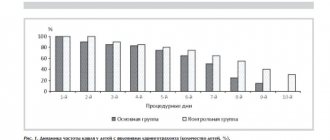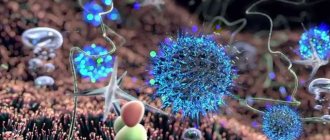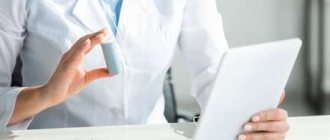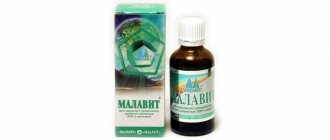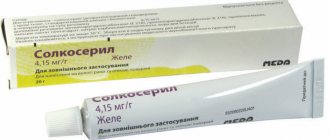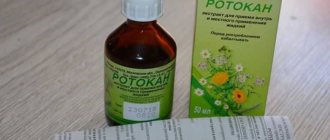Pharmacological properties of the drug Miramistin
Pharmacodynamics. The action of miramistin is based on the direct hydrophobic interaction of the molecule with the lipids of the membranes of microorganisms, leading to their fragmentation and destruction. In this case, part of the miramistin molecule, plunging into the hydrophobic portion of the membrane, destroys the supra-membrane layer, loosens the membrane, increases its permeability to high-molecular substances, changes the enzymatic activity of the microbial cell, inhibiting enzyme systems, which leads to inhibition of the vital activity of microorganisms and their cytolysis. Unlike other antiseptics, Miramistin has a highly selective action against microorganisms, since it has virtually no effect on human cell membranes. This effect is associated with a different structure of human cell membranes (much longer lipid radicals, which sharply limit the possibility of hydrophobic interaction of miramistin with cells). Miramistin has a pronounced antimicrobial effect against gram-positive and gram-negative, aerobic and anaerobic, spore-forming and asporogenic bacteria in the form of monocultures and microbial associations, including hospital strains with multidrug resistance to antibiotics. It has a detrimental effect on pathogens of sexually transmitted diseases: gonococci, Treponema pallidum, Trichomonas, chlamydia, selectively on herpes viruses. Has an antifungal effect on ascomycetes of the genus Aspergillus and kind Penicillium, yeast (Rhodotorula rubra, Torulopsis gabrata etc.) and yeast-like (Candida albicans, Candida tropicalis, Candida krusei etc.) mushrooms, dermatophytes (Trichophyton rubrum, Trichophyton mentagrophytes, Trichophyton verrucosum, Trichophyton schoenleini, Trichophyton violaceum, Epidermophyton Kaufman-Wolf, Epidermophyton floccosum, Microsporum gypseum, Microsporum canis etc.), as well as other pathogenic fungi (for example Pityrosporum orbiculare (Malassezia furfur)) in the form of monocultures and microbial associations, including fungal microflora with resistance to chemotherapeutic drugs. Under the influence of miramistin, the resistance of microorganisms to antibiotics decreases. Miramistin has an anti-inflammatory and immunoadjuvant effect, enhances local protective reactions, regenerative processes, activates nonspecific defense mechanisms due to modulation of the cellular and local humoral immune response. Pharmacokinetics. When applied topically, it is not absorbed through the skin and mucous membranes.
Description
Miramistin is a domestic broad-spectrum antiseptic drug that is used for the prevention and treatment of bacterial, fungal and viral infections. Initially, the drug was intended to disinfect compartments on Soviet spaceships and stations. And now Miramistin has shown itself to be excellent in the prevention and therapeutic treatment of wounds, purulent-septic processes, the appearance of which accompanies surgery and traumatology. Miramistin effectively fights pathogenic microorganisms, therefore it is applicable in gynecology, urology, dentistry, otolaryngology and other branches of medicine.
But you should not think that Miramistin simply has an antimicrobial effect; it is quite strong and fights even those strains that are insensitive to other antibiotics. Miramistin interacts with ascomycetes, yeast and yeast-like fungi, dermatophytes, and some other pathogenic fungi. And what is especially important, Miramistin is able to influence human immunodeficiency viruses, herpes, etc. That is, demonstrate an antiviral effect. The medicine is also quite active against pathogens that cause sexually transmitted diseases (STDs).
Miramistin prevents infection of burns and wounds, as it accelerates the absorption of purulent secretions, stimulates the process of tissue regeneration and the manifestation of the body's protective reactions.
And all these wonderful properties practically do not cause allergic reactions or irritation to the skin. This is what it means that the product was developed for the space industry.
Indications for use of the drug Miramistin
surgery, traumatology: prevention of suppuration and treatment of purulent wounds: treatment of purulent-inflammatory processes of the musculoskeletal system. Obstetrics - gynecology: prevention and treatment of suppuration of postpartum injuries, wounds of the perineum and vagina; postpartum infections; inflammatory diseases of the genital organs (vulvovaginitis, endometritis). Combustiology: treatment of superficial and deep burns of II–IIIA degrees, preparation of burn wounds for autodermoplasty. Dermatology, venereology: treatment of candidiasis of the skin and mucous membranes, mycoses of the feet and large folds; prevention of sexually transmitted diseases (syphilis, gonorrhea, genital herpes, genital candidiasis). Urology: complex treatment of acute and chronic urethritis and urethroprostatitis of specific (chlamydia, trichomoniasis, gonorrhea) and nonspecific nature. Dentistry: treatment of periodontitis, stomatitis, hygienic treatment of removable dentures. Otolaryngology: complex treatment of acute and chronic otitis, sinusitis, tonsillitis, laryngitis.
Features of use during pregnancy and children
The drug can be used by patients of different age categories. It is absolutely safe for pregnant and nursing mothers, since it does not penetrate the mucous membrane or the upper layer of the epithelium. The active substance is not absorbed in the blood. Before using the drug, in order to prevent the manifestation of an allergic reaction, it is worth conducting a hypersensitivity test. To do this, apply a little solution to the skin in the wrist area and rub thoroughly. The body's reaction is assessed after 10–15 minutes. If there is no inflammation, redness, blisters, or rash, then Miramistin can be safely used.
The drug is indicated for children from 3 years of age. Taking the solution at an earlier age is possible only as prescribed by a doctor and under his supervision.
Use of the drug Miramistin
Locally. Surgery, traumatology, combustiology. For preventive and therapeutic purposes, miramistin is used to irrigate the surface of wounds and burns, loosely pack wounds and fistula tracts, and fix gauze swabs moistened with an antiseptic. The treatment procedure is repeated 2–3 times a day for 3–5 days. The method of active drainage of wounds and cavities with a daily consumption of about 1 liter of the drug is highly effective. Obstetrics - gynecology . In order to prevent postpartum infection, 50 ml of the drug is used in the form of vaginal tampons with an exposure of 2 hours for 5 days in the form of vaginal irrigations before childbirth (5–7 days), during childbirth after each vaginal examination and in the postpartum period. When delivering by caesarean section, the vagina is treated immediately before the operation, during the operation - the uterine cavity and the incision on it, and in the postoperative period, tampons moistened with 50 ml of solution are inserted into the vagina with an exposure of 2 hours for 7 days. Treatment of inflammatory diseases of the female genital organs is carried out by intravaginal administration of tampons with the drug for 2 weeks, as well as administration of the drug by electrophoresis. Venereology . For the prevention of sexually transmitted diseases, Miramistin is effective if it is used no later than 2 hours after sexual intercourse. Using the nozzle, insert the contents of the bottle into the urethra of men (2–3 ml), women (1–2 ml), into the vagina (5–10 ml) and into the urethra (1–2 ml) for 2–3 minutes. The skin of the inner thighs, pubis, and genitals is treated. Urology. In the complex treatment of urethritis and ureoprostatitis by endourethral instillation of 2–3 ml of 0.01% miramistin solution 1–2 times a day, course - 10 days. The procedure is repeated every other day. Otorhinolaryngology . In the complex treatment of purulent sinusitis, during puncture the maxillary sinus is washed with a sufficient amount of antiseptic. In the treatment of tonsillitis and laryngitis, repeated gargling with a solution of the drug is carried out. Dentistry . Treatment of periodontitis by introducing turundas moistened with miramistin solution into periodontal pockets, followed by applications to the gums for 15 minutes. During exacerbations, rinsing periodontal pockets with Miramistin using a syringe and introducing turundas moistened with the drug into the abscess cavity are used. After vestibuloplasty and frenulectomy, Miramistin is used in the form of baths on an outpatient basis. Miramistin is used for medicinal treatment of carious cavities, tooth canals after pulp extraction, and hygienic treatment of removable dentures.
Why do you need to rinse your mouth after tooth extraction?
After the tooth extraction procedure, a hole with damaged blood vessels remains. A blood clot forms in it, protecting the wound from infection. New mucous membrane grows under it, and the periosteum heals. If the clot is accidentally removed or washed out, bleeding may resume. The wound will become vulnerable to various infections. For this reason, complications often develop. Therefore, oral care after tooth extraction should be extremely careful.
Rinsing is prescribed to prevent wound infection and the occurrence of purulent-septic complications. They promote rapid healing of the gums and reduce swelling that is possible after surgery. Only a doctor can tell you whether it is necessary and possible to rinse your mouth after tooth extraction. Trying to treat a wound on your own can be harmful.
Special instructions for the use of the drug Miramistin
The drug does not have a local irritant effect and does not have allergenic properties. Venereology. Urology. After treating the urethra, vagina, inner thighs, pubis and genitals with miramistin, it is not recommended to urinate for 2 hours. Use during pregnancy and lactation. Since drug resorption is almost completely absent, Miramistin can be used during pregnancy and lactation. The ability to influence the reaction rate when driving a vehicle or working with other mechanisms. During treatment with the drug, it is possible to drive vehicles and engage in other potentially hazardous activities that require increased concentration and speed of psychomotor reactions.
How to rinse your mouth with Miramistin after tooth extraction
In the first 1–2 days after extirpation, any rinsing is prohibited. Otherwise, you can wash the clot out of the well. If an infection gets into it, alveolitis or osteomyelitis will begin. In the first case, the socket becomes inflamed, in the second – the bone. That's why they only do baths. Take one sip (10–15 ml) of liquid at room temperature into your mouth, hold it for 1–2 minutes and spit it out.
Next, you should adhere to the following rules:
- Starting from the 3rd–4th day, you can carry out gentle rinsing. To do this, you need to tilt your head several times from the side of the extracted tooth to the healthy one.
- Baths and rinses are carried out immediately after meals.
- After treating the oral cavity with Miramistin for 1–1.5 hours (optimally up to two), you should refrain from smoking, drinking and eating.
In most cases, patients are prescribed 3-4 rinses per day. The course of treatment is up to a week.
After tooth extraction, patients should also pay special attention to oral care. If you are concerned about whether it is possible to do ordinary hygienic rinses, then you should also avoid them at first. In order to maintain hygiene, patients are recommended to use the same baths. To do this, take warm water into your mouth, hold it a little and spit it out. And so several times until you feel fresh.
Why is Miramistin prescribed in gynecology?
In gynecology, the drug can be used for:
- Impregnation of vaginal tampons. This method of administering an antiseptic shows good results in the treatment of cervical erosion, metritis, and endometritis.
- Douching. The method is widely used for the treatment and prevention of sexually transmitted diseases.
- Introduction into the genitourinary canal using a catheter is a method of treating urethritis and cystitis. The manipulation can only be performed by a person with medical education.
- Electrophoresis sessions. Physiotherapeutic procedures using Miramistin help cure pelvic pathologies such as salpingitis, oophoritis, etc.
The method of treatment and duration of therapy are selected by the attending physician in each specific case.
Inflammation of periodontal tissues
The drug is used for antiseptic treatment of the oral mucosa during the treatment of gingivitis, periodontitis and periodontal disease. In combination with other measures (for example, taking antibiotics, brushing teeth from plaque and tartar, plasma lifting and injections of hyaluronic acid, bioactive gels), the product helps relieve inflammation and swelling of tissues, get rid of bleeding and increased sensitivity of the gums.
The drug is used for periodontitis
A few words about the history of the creation of the drug
"Miramistin" as a drug first began to be developed in the distant 70s. At first, it was promoted as a composition that was supposed to be used at interorbital stations to disinfect the skin of astronauts and to treat objects, things, and workplaces around them. However, after the collapse of the USSR, research on the active antiseptic substance miramistin was suspended; they were returned to them again in the late nineties. It was then that the medicine first began to be put on sale, but to solve narrow-profile problems (for example, the prevention of sexually transmitted diseases). There was no talk of him as a child at all.
Miramistin allows you to solve problems in many areas of medicine
Later, additional studies were carried out, which allowed specialists to expand the list of areas of application of the drug. And its safety, almost one hundred percent effectiveness and the absence of contraindications, except for individual intolerance, made it possible to use Miramistin for children.
Today the drug is produced by a production facility located in the Moscow region. The medicine is in demand in Russia, Ukraine, Belarus, Kazakhstan, Turkmenistan, and Armenia. They also plan to sell the product in China soon1.
Now let’s look at the cases in which doctors at dental clinics recommend using the drug. You need to understand that Miramistin is equally often prescribed in both pediatric and adult dentistry as an additional measure to the main treatment. It is not a panacea, but the instructions for its use state that, in combination with other measures, it helps get rid of various problems.
Comments
Miramistin is really good, but it’s just expensive, almost 400 rubles for 150 milliliters. What is the best way to replace it?
Cherkassova Dilyara (09.10.2020 at 23:29) Reply to comment
- Dear Dilyara, in terms of the principle of action and set of positive properties, budget drugs such as Chlorhexidine and Furacilin are similar to Miramistin. But before using them, do not forget to consult your doctor, because they have a number of contraindications.
Editorial staff of the portal UltraSmile.ru (10/13/2020 at 09:14) Reply to comment


